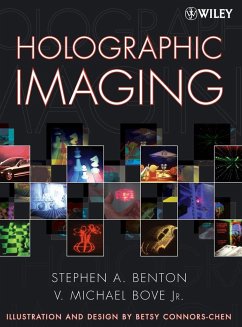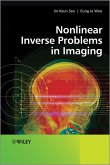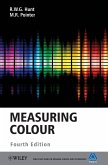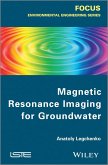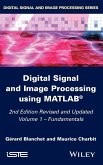Holographic Imaging covers the three dimensional imaging technique of holography. It covers the fundamental physical and optical principles of using diffraction to record and reconstruct images, human perception, and the history of holographic imaging with an approachable explanation of both basic and advanced holographic concepts.
The only all-inclusive treatment of holography-from fundamental principles to the most advanced concepts
While several existing texts cover different aspects of the field of holography, none provides a complete, up-to-date, and accessible view of its popular, scientific, and engineering aspects. Now, from an author team that includes one of the world's pioneers in the field, Holographic Imaging fills this need with a single, comprehensive text that covers the subject from traditional holography to the cutting-edge development of the world's most advanced three-dimensional holographic images, holographic printing, and holographic video.
Written in an engaging and easy-to-follow style, Holographic Imaging promotes a hands-on approach to making holograms and provides readers with a working understanding of how and why they work. Following a brief introduction to the fundamentals of light and diffraction, coverage includes: the diffraction efficiency of gratings, "platonic" holography, a ray-tracing analysis of holography, holographic lenses and in-line "Gabor" holography, off-axis "Leith & Upatnieks" holography, non-laser illumination of holograms, phase conjunction and real image projection, full-aperture transfer holography, white-light transmission "rainbow" holography, practical issues in rainbow holography, in-line "Denisyuk" reflection holography, off-axis reflection holography, edge-lit holography, computational display holography, holographic printing, and holographic television.
Helpful diagrams and equations that summarize the mathematical and physical principles for each technique discussed make this an approachable resource for readers from a variety of backgrounds, including undergraduate and postgraduate students with an interest in optics, optoelectronics, and information display, as well as researchers, scientists, engineers, and technology-savvy artists.
The late Stephen A. Benton, PhD, invented the white-light viewable "rainbow" hologram seen on credit cards and magazine covers. As a professor at MIT, he went on to invent the world's first real-time, interactive, holographic video system. Dr. Benton established the Spatial Imaging Group at MIT to conduct research in 3-D display technologies and later became one of the MIT Media Laboratory's founding faculty members. He was a fellow of the Optical Society of America and of the Society for Imaging Science and Technology. A prolific author and inventor, he held numerous patents in optical physics, photography, and holography.
Hinweis: Dieser Artikel kann nur an eine deutsche Lieferadresse ausgeliefert werden.
The only all-inclusive treatment of holography-from fundamental principles to the most advanced concepts
While several existing texts cover different aspects of the field of holography, none provides a complete, up-to-date, and accessible view of its popular, scientific, and engineering aspects. Now, from an author team that includes one of the world's pioneers in the field, Holographic Imaging fills this need with a single, comprehensive text that covers the subject from traditional holography to the cutting-edge development of the world's most advanced three-dimensional holographic images, holographic printing, and holographic video.
Written in an engaging and easy-to-follow style, Holographic Imaging promotes a hands-on approach to making holograms and provides readers with a working understanding of how and why they work. Following a brief introduction to the fundamentals of light and diffraction, coverage includes: the diffraction efficiency of gratings, "platonic" holography, a ray-tracing analysis of holography, holographic lenses and in-line "Gabor" holography, off-axis "Leith & Upatnieks" holography, non-laser illumination of holograms, phase conjunction and real image projection, full-aperture transfer holography, white-light transmission "rainbow" holography, practical issues in rainbow holography, in-line "Denisyuk" reflection holography, off-axis reflection holography, edge-lit holography, computational display holography, holographic printing, and holographic television.
Helpful diagrams and equations that summarize the mathematical and physical principles for each technique discussed make this an approachable resource for readers from a variety of backgrounds, including undergraduate and postgraduate students with an interest in optics, optoelectronics, and information display, as well as researchers, scientists, engineers, and technology-savvy artists.
The late Stephen A. Benton, PhD, invented the white-light viewable "rainbow" hologram seen on credit cards and magazine covers. As a professor at MIT, he went on to invent the world's first real-time, interactive, holographic video system. Dr. Benton established the Spatial Imaging Group at MIT to conduct research in 3-D display technologies and later became one of the MIT Media Laboratory's founding faculty members. He was a fellow of the Optical Society of America and of the Society for Imaging Science and Technology. A prolific author and inventor, he held numerous patents in optical physics, photography, and holography.
Hinweis: Dieser Artikel kann nur an eine deutsche Lieferadresse ausgeliefert werden.
"This text successfully covers its subject, from theoretical holography, traditional technology, and widespread rainbow holograms, to the latest, cutting edge technological developments of the holographic television and holographic computer displays. It does so with an easy to follow style, approachable mathematics, and helpful illustrations. This makes the book a valuable resource for readers from a variety of backgrounds, including students and researchers in optics, optoelectronics, computer science, and engineering." ( Computing Reviews , December 2, 2008)

